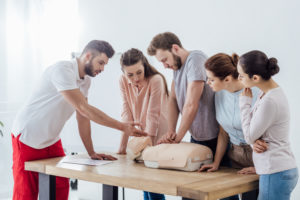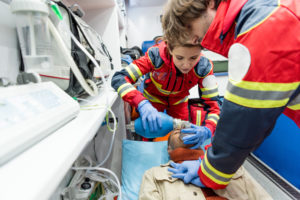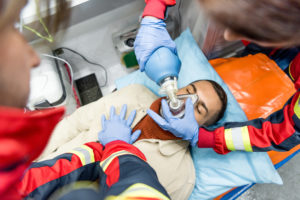As a key player in the medical training landscape, United Medical Education remains committed to your success. We’re not just an online learning platform – we’re your partner in preparing for critical life-saving certifications. Today, we want to share some valuable tips to help you pass the Basic Life Support (BLS) training exam.
 1. Understand the Basics
1. Understand the Basics
BLS isn’t just a series of steps. It’s a lifesaving process grounded in a solid understanding of the human body and how it responds to emergency situations. Grasping the fundamentals of BLS, including CPR, AED use, and managing choking cases, will set you on the path to success in your BLS exam. Besides quick tips, we will share where to find simple resources to complete your BLS training fast.
2. Use the Free Training Resources
At United Medical Education, we offer free BLS training to all of our registered students. When you build your free student account, you gain access to comprehensive, easy-to-understand modules that cover every aspect of BLS. Utilize these resources to familiarize yourself with BLS principles, procedures, and guidelines.
3. Take Advantage of Practice Exams
One of the most effective ways to prepare for any exam is by doing practice exams. Not only do they familiarize you with the format and style of questions, but they also help identify areas where you might need further study. Our practice exams are comprehensive and free, providing a valuable tool for your preparation.
4. Regular Review and Consistency
Cramming isn’t the best strategy when it comes to mastering BLS. Start your study plan well in advance of your exam date, reviewing the material regularly and consistently. This approach will help ensure the information is deeply embedded in your long-term memory, making recall easier during the actual exam.
 5. Stay Updated on Guidelines
5. Stay Updated on Guidelines
The BLS field evolves as new research and information emerge. Stay up-to-date with the latest guidelines and research. United Medical Education ensures its training materials align with the most current BLS guidelines, helping our students stay ahead of the curve.
6. Cultivate a Calm Mind
BLS scenarios can be stressful, and the same can apply to BLS exams. Cultivating a calm and focused mind will help manage anxiety and improve your performance. Practicing mindfulness, doing deep-breathing exercises, or using other stress-management techniques can be very helpful.
7. Seek Support When Needed
You’re not alone in this journey. United Medical Education is here to support you, providing expert advice and answers to your questions. Don’t hesitate to reach out if you need help with your preparation or any aspect of your BLS training.
At United Medical Education, we’re dedicated to your success in BLS training. Our resources are freely accessible, providing you with comprehensive knowledge, hands-on experience, and the confidence to pass your BLS exam.
The power to save a life could be in your hands. Take the first step towards BLS certification today, because every second counts.
A Story to Remember
My friend Olivia, a veteran nurse and a mentor to many nursing students that attend a local college, often talks about the importance of understanding the material rather than just memorizing it. She vividly recalls the time she was preparing for her BLS exam. Rather than looking for shortcuts, she fully dedicated herself to understanding the principles and protocols of BLS. Her mantra was “Knowledge, not memorization, ensures competence and confidence.” Not surprisingly she passed her BLS exam on the first attempt. Now she encourages everyone preparing for their BLS exam to take the same approach.
 What are the 5 Steps of BLS Assessment?
What are the 5 Steps of BLS Assessment?
The 5 steps of BLS assessment are vital to any emergency scenario. They include:
- Scene safety: Ensure the environment is safe for both you and the victim.
- Check responsiveness: Check if the victim is conscious and responsive.
- Call for help or an AED: If the victim is unresponsive, call for medical help or an Automated External Defibrillator (AED).
- Check breathing and pulse: Look for signs of breathing and a pulse.
- Begin CPR: If the victim isn’t breathing or doesn’t have a pulse, start performing CPR.
What are the Key Points of BLS Training?
BLS training centers on teaching students how to recognize various life-threatening emergencies, provide high-quality chest compressions, deliver appropriate ventilations, and provide early use of an AED. In addition, it incorporates the steps to perform prompt, effective BLS in both in-facility and prehospital settings.
How Many Questions are on the BLS Test?
The BLS exam typically consists of 25 multiple-choice questions. These questions cover a range of topics including CPR, AED use, and emergency procedures. Success in the exam depends on understanding the core BLS principles and having a strong practical understanding of BLS procedures.
What are the 4 Basic Life Supports?
The 4 basic life supports are:
- Airway: Maintain an open airway for the victim.
- Breathing: Support the victim’s breathing.
- Circulation: Aid the circulation of blood in the victim.
- Defibrillation: Use defibrillation when necessary and possible.
What is the 30:2 Rule in CPR?
The 30:2 rule in CPR refers to giving 30 chest compressions followed by 2 rescue breaths during a CPR cycle. This sequence is recommended for one-rescuer CPR on adults. It’s important to follow this guideline to ensure the victim receives the right balance of air and circulation support.
What are the Three P’s of Life Support?
The three P’s of life support stand for Preserve Life, Prevent Further Injury, and Promote Recovery. They form a guiding principle in all life support scenarios. Preserving life and preventing further injury involve immediate actions to stabilize the victim, while promoting recovery entails the ongoing care after initial treatment.
What are the ABCs of BLS?
The ABCs of BLS stand for Airway, Breathing, and Circulation, and they guide the response to emergencies. Ensuring the Airway is open, supporting Breathing, and assisting Circulation are crucial steps in life-saving BLS. With the evolution of BLS guidelines, “D” for Defibrillation has also been included, highlighting the importance of early defibrillation.

 1. Understand the Basics
1. Understand the Basics 5. Stay Updated on Guidelines
5. Stay Updated on Guidelines What are the 5 Steps of BLS Assessment?
What are the 5 Steps of BLS Assessment?